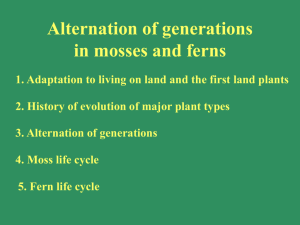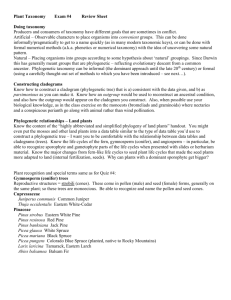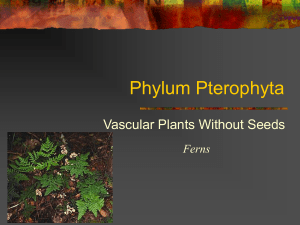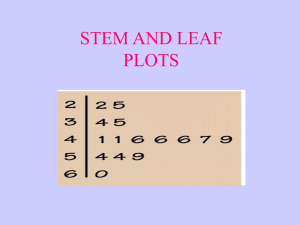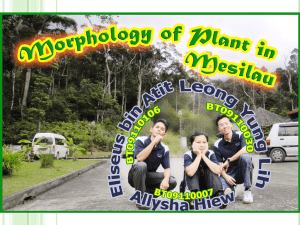Fern Morphology & Life Cycle: Plant Biology Presentation
advertisement
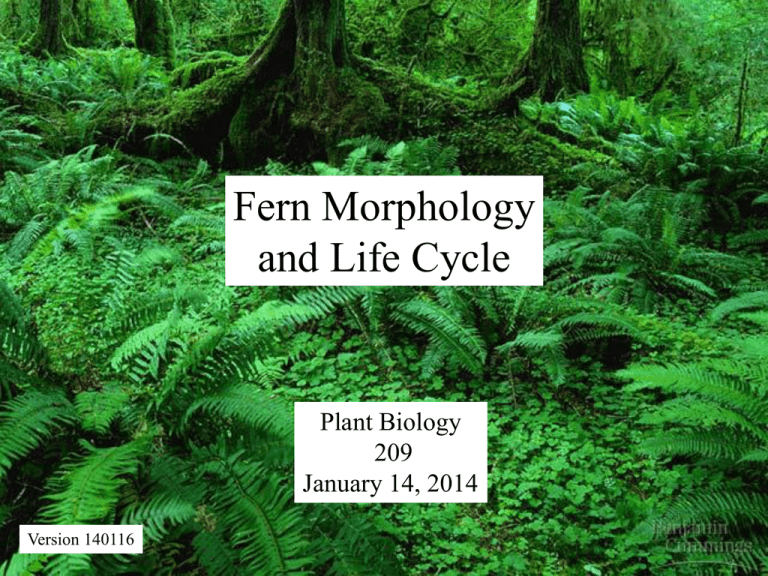
Fern Morphology and Life Cycle Plant Biology 209 January 14, 2014 Version 140116 Spore dispersal Siphonosteles Megaphylls Five lineages are included in the monilophyte clade: • Equisetophytes (horsetails) • Psilotales (whisk ferns) Three of them are considered “ferns”: •Marattiales •Ophioglossales (grape ferns) •Polypodiales Gametophyte (n) -74 Sporophyte (2n) Blueprint: the Land Plants Life Cycle The Sporophyte Phase The Sporophyte Phase There are four plant organs: I. The Vegetative Body: A.The Shoot: 1. Stem 2. Leaf B. The Root II. The Reproductive Body: Sporangia Flowers (= Leaves + Sporangia) Vegetative Body: the Stem CHARACTERISTICS POLYPODIALES SEED PLANTS apical meristem with a single tetrahedral apical initial cell Many initials stem protoxylem in islands Stem protoxylem primitively continuous VARIATION buds not axillary (buds in other Buds axillary positions) stem vascular tissue in a siphonostele (at least not a eustele) Stem vascular tissue in a eustele wood (and cambium) absent Cambium present POLYPODIALES SEED PLANTS apical meristem with a single tetrahedral apical initial cell Many initials stem vascular tissue in a siphonostele (usually) POLYPODIALES SEED PLANTS Vegetative Body: the Stem VARIATION • Stems creeping or erect (tree ferns - but no wood!) • Siphonostele varies in compaction of leaf gaps. • Epidermal coverings (indument) are hairs or scales. Our New England Ferns Have a Creeping Rhizome more or less upright long-creeping Rhizome habit: is the underground stem ± upright or is it long-creeping? Tree ferns have erect stems. Variations on the siphonostele A B C D B,C, and D are dictyostelic siphonosteles because their leaf gaps overlap Indument: of hairs, scales, or both Osmunda Woodsia Dryopteris Indument of Scales (Dryopteris) Indument of Hairs (Lophosoria) Variation in petiole scales of scaly tree ferns (Cyatheaceae) Indument of Hairs and Scales (Phegopteris) Vegetative Body: the Leaf • The fern leaf is a megaphyll • Vernation is circinate The Frond (Leaf) Fiddleheads (croziers) Leaf Dissection Lady fern (leaf twice-pinnate pinnatisect) Walking fern (leaf entire) Christmas fern (leaf once-pinnate) Reproductive Body: Sporangia • Sporangia are commonly borne in clusters called sori • They are of the leptosporangiate type • They are often covered by an indusium. • Sori vary in shape and position. The sorus of Cyrtomium from above, covered by its true indusium Marginal sori of purplestemmed cliffbrake Abaxial sori of Polypodium Fern sori differ in shape, position, and presence or absence of an indusium Leptosporangia - Sporangia small (ca 0.25 mm in diameter) - Sporangial walls one cell layer thick plus tapetum - Sporangia develop from a single sporangial initial - Sporangia produce relatively few spores (commonly 64) Eusporangia - Sporangia large (> 0.5 mm in diameter) - Sporangial walls several cell layers thick - Sporangia develop from a group of sporangial initials - Sporangia produce a large number of spores. Leptsporangium Structure and Dehiscence Spore Catapult Video Sporangium development tapetum tapetum Fern spores are either trilete or monolete Trilete spore (e.g., Adiantum) Monolete spore (e.g., Polystichum) Fern spores are either trilete or monolete Trilete spore Jamesonia imbricata Monolete spore Lomariopsis guineensis The Gametophyte Phase Spore germination and early growth, Ceratopteris rhizoid spore wall General Features of Fern Gametophyte Development Antheridia Fern sperm are helical and multiflagellate from Raven… The transition from zygote to embryonic sporophyte From Raven Stable (versus labile) characters of the Polypodiales: • • • • Stems have siphonosteles (most species) Apex has a single tetrahedral apical initial Leaves are megaphylls with circinate vernation (croziers) Sporangia usually abaxial (on the lower surface, i.e. away from the stem), leptosporangiate, in sori (most species) • Gametophytes are green and thallose (that is broad and flat), not axial (that is with an elongating meristem). First characters to evaluate in the ferns: • • • • • • Stem habit: erect or creeping, long internodes or short? Leaf shape: broadest at base, middle, above middle? Leaf dissection: once-pinnate, twice pinnate, etc. Indument: of hairs, scales, or both? Sorus shape and position: round and near margin, etc. Indusium: present or absent
